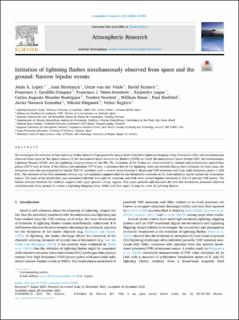| dc.contributor.author | López, Jesús A. | |
| dc.contributor.author | Montanyà, Joan | |
| dc.contributor.author | van der Velde, Oscar | |
| dc.contributor.author | Romero, David | |
| dc.contributor.author | Gordillo-Vázquez, Francisco J. | |
| dc.contributor.author | Pérez-Invernón, Francisco J. | |
| dc.contributor.author | Luque, Alejandro | |
| dc.contributor.author | Morales Rodriguez, Carlos Augusto | |
| dc.contributor.author | Neubert, Torsten | |
| dc.contributor.author | Rison, William | |
| dc.contributor.author | Krehbiel, Paul | |
| dc.contributor.author | González, Javier Navarro | |
| dc.contributor.author | Østgaard, Nikolai | |
| dc.contributor.author | Reglero, Víctor | |
| dc.date.accessioned | 2023-02-27T09:26:17Z | |
| dc.date.available | 2023-02-27T09:26:17Z | |
| dc.date.created | 2022-05-09T13:11:01Z | |
| dc.date.issued | 2022 | |
| dc.identifier.issn | 0169-8095 | |
| dc.identifier.uri | https://hdl.handle.net/11250/3054091 | |
| dc.description.abstract | We investigate the initiation of four lightning flashes detected from ground by means of the Colombia Lightning Mapping Array (Colombia-LMA) and simultaneously observed from space by the optical sensors of the Atmosphere-Space Interactions Monitor (ASIM) on board the International Space Station (ISS), the Geostationary Lightning Mapper (GLM), and the Lightning Imaging Sensor on the ISS. The initiations of the flashes are characterized by isolated and predominant optical blue pulses (337.0 nm). In three of the flashes, red emissions (777.4 nm), a dominant line of hot lightning, were not detected during their initiation. In these cases, the initiations were also accompanied by bipolar VLF/LF waveform with a narrow short duration (<40 μs) and VHF emissions with high radio frequency power (<269 kW). The detection of the blue emissions without any red luminosity supports that the fast breakdown processes at the flash initiation can be exclusively of streamer nature. The onset of the fourth flash was associated with both blue and red radiation, and with weak narrow bipolar waveform in VLF/LF and low VHF power. The flashes initiated between the midlevel negative and upper positive charge regions. This paper presents and discusses the first fast breakdown processes observed simultaneously from ground by means a Lightning Mapping Array (LMA) and from space during the onset of lightning flashes. | en_US |
| dc.language.iso | eng | en_US |
| dc.publisher | Elsevier | en_US |
| dc.rights | Attribution-NonCommercial-NoDerivatives 4.0 Internasjonal | * |
| dc.rights.uri | http://creativecommons.org/licenses/by-nc-nd/4.0/deed.no | * |
| dc.title | Initiation of lightning flashes simultaneously observed from space and the ground: Narrow bipolar events | en_US |
| dc.type | Journal article | en_US |
| dc.type | Peer reviewed | en_US |
| dc.description.version | publishedVersion | en_US |
| dc.rights.holder | Copyright 2021 The Authors | en_US |
| dc.source.articlenumber | 105981 | en_US |
| cristin.ispublished | true | |
| cristin.fulltext | original | |
| cristin.qualitycode | 1 | |
| dc.identifier.doi | 10.1016/j.atmosres.2021.105981 | |
| dc.identifier.cristin | 2022688 | |
| dc.source.journal | Atmospheric research | en_US |
| dc.identifier.citation | Atmospheric Research. 2022, 268, 105981. | en_US |
| dc.source.volume | 268 | en_US |

